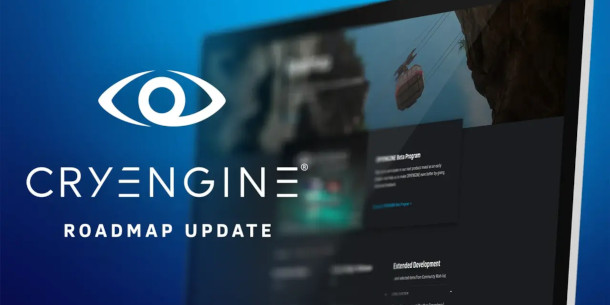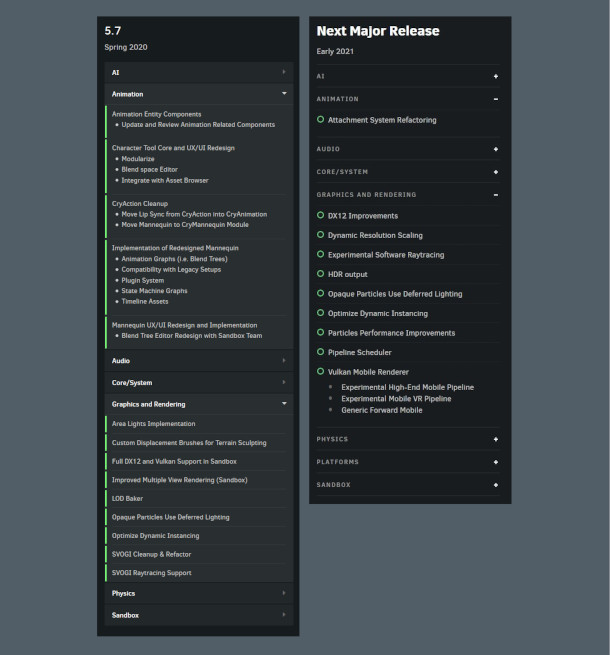Crytek posts its 2021 CryEngine roadmap

Crytek has updated its 2021 product roadmap for CryEngine, showing the new features due in the next two updates to the game engine.
The next update, now due in “early 2021” includes features originally scheduled for CryEngine 5.7 this spring, including a new ray tracing system and a replacement for the Schematyc visual programming environment.
Not quite the insight into development Crytek probably hoped for
When it first posted its public roadmap last May, Crytek acknowledged that the information had “been a long time coming”, and that it hoped to “provide more transparency and insight into … development”.
Judged on that basis, the project has had mixed results: CryEngine 5.6 shipped last August with the features scheduled, but there has been no sign of CryEngine 5.7, originally due in “spring 2020”.
In its latest blog post, the firm once more acknowledges that new information has “been a long time coming” and that “some of our goals and deadlines have been pushed out”.

Then and now: animation and graphics features originally scheduled for CryEngine 5.7 this spring (left), and the shorter list now due in the next update in early 2021 (right). Area lights shipped in CryEngine 5.6.
Key features originally due in CryEngine 5.7 now coming in 2021
Of those goals, one of the most significant is the new hardware-agnostic ray tracing system that Crytek announced at GDC 2019, and originally scheduled for CryEngine 5.7.
In the new roadmap, that seems to have been downgraded to “experimental software raytracing”, and is now scheduled for an as-yet-unnumbered release in “early 2021”.
Other proposed graphics features like full DirectX 12 and Vulkan support in the editor have now been pushed back to the release after that, for which no timescale is given.
In addition, a number of graphics and animation features have simply been removed from the R&D section of the roadmap, which has been shortened considerably since its previous incarnation.
That includes the new procedural animation system, which was to include muscle simulation via pose-space deformation, animation mirroring and retargeting, and run-time character rigging.
The R&D entries are now described as “selected items” from the community wish list, so it may not be gone for good, but it does suggest that it isn’t a development priority.
Also in the 2021 update: HDR output, new mobile renderer and visual scripting system
However, a few graphics features have actually moved forward on the schedule, including support for HDR output: originally a R&D feature, but now due in the 2021 release.
Other features planned for the release include an “experimental” implementation of a new Vulkan-based mobile renderer, and a long-awaited successor to the old Schematyc visual scripting system.
In addition, UI creation system Scaleform will be updated from Scaleform 2 to Scaleform 4, the last stable release, although Autodesk actually stopped selling the middleware three years ago.
The release will also bring improvements to both CryEngine’s native CryPhysics and PhysX physics systems, and to FBX import, although the roadmap doesn’t provide any more detail than that.
Further off: updates to the character tools, support for next-gen hardware
Features now simply listed as scheduled for the next “future major release”, include a UI/UX update to the Character Tool core, including a new blend space editor, and updates to the character animation tools.
Both were originally scheduled for CryEngine 5.7 this spring.
Other changes scheduled for the same update include support for macOS in the CryEngine editor, and support for publishing games to Google Stadia and “next-gen hardware”.
No version number or timescale is now given for the release.
Pricing and system requirements
The current stable release, CryEngine 5.6, is available for Windows 7+. Use of the editor is free, but Crytek charges 5% of the revenue from any commercial project using the engine after the first $5,000/year.
Read a full list of features scheduled for CryEngine in 2021 in Crytek’s product roadmap
